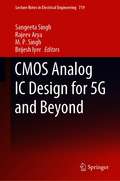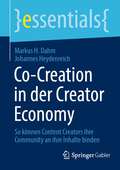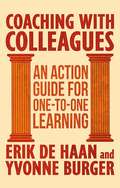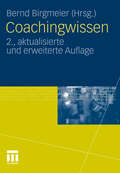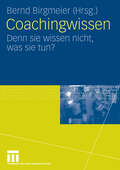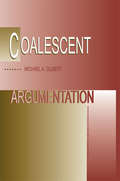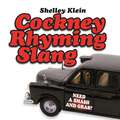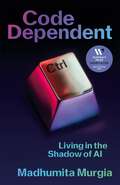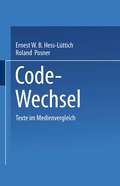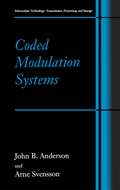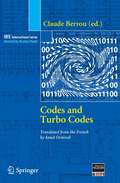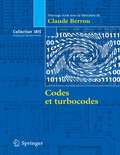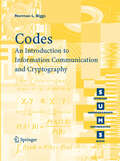- Table View
- List View
CMOS Analog IC Design for 5G and Beyond (Lecture Notes in Electrical Engineering #719)
by Sangeeta Singh Rajeev Arya M. P. Singh Brijesh IyerThis book is focused on addressing the designs of FinFET-based analog ICs for 5G and E-band communication networks. In addition, it also incorporates some of the contemporary developments over different fields. It highlights the latest advances, problems and challenges and presents the latest research results in the field of mm-wave integrated circuits designing based on scientific literature and its practical realization. The traditional approaches are excluded in this book. The authors cover various design guidelines to be taken care for while designing these circuits and detrimental scaling effects on the same. Moreover, Gallium Nitrides (GaN) are also reported to show huge potentials for the power amplifier designing required in 5G communication network. Subsequently, to enhance the readability of this book, the authors also include real-time problems in RFIC designing, case studies from experimental results, and clearly demarking design guidelines for the 5G communication ICs designing. This book incorporates the most recent FinFET architecture for the analog IC designing and the scaling effects along with the GaN technology as well.
CMOS Cascade Sigma-Delta Modulators for Sensors and Telecom: Error Analysis and Practical Design (Analog Circuits and Signal Processing)
by Rocío Río Fernández Fernando Medeiro Hidalgo Belén Pérez Verdú José Manuel Rosa Utrera Ángel Rodríguez-VázquezInstitutional book, not really for bookstore catalogue The book contains valuable information structured to provide insight on how to design SC sigma-delta modulators. It presents architectures, circuits, models, methods and practical considerations for the design of high-performance low-pass switched-capacitor (SC) sigma-delta A/D interfaces for mixed-signal CMOS ASICs. The main focus of the book is on cascade architectures. It differs from other books in the complete, in-depth coverage of SC circuit errors.
CMOS-Compatible Key Engineering Devices for High-Speed Silicon-Based Optical Interconnections (Springer Theses)
by Jing WangThis book discusses some research results for CMOS-compatible silicon-based optical devices and interconnections. With accurate simulation and experimental demonstration, it provides insights on silicon-based modulation, advanced multiplexing, polarization and efficient coupling controlling technologies, which are widely used in silicon photonics. Researchers, scientists, engineers and especially students in the field of silicon photonics can benefit from the book. This book provides valuable knowledge, useful methods and practical design that can be considered in emerging silicon-based optical interconnections and communications. And it also give some guidance to student how to organize and complete an good dissertation.
CMOS Multichannel Single-Chip Receivers for Multi-Gigabit Optical Data Communications (Analog Circuits and Signal Processing)
by Paul Muller Yusuf LeblebiciIn the world of optical data communications this book will be an absolute must-read. It focuses on optical communications for short and very short distance applications and discusses the monolithic integration of optical receivers with processing elements in standard CMOS technologies. What’s more, it provides the reader with the necessary background knowledge to fully understand the trade-offs in short-distance communication receiver design and presents the key issues to be addressed in the development of such receivers in CMOS technologies. Moreover, novel design approaches are presented.
CMOS Single Chip Fast Frequency Hopping Synthesizers for Wireless Multi-Gigahertz Applications: Design Methodology, Analysis, and Implementation (Analog Circuits and Signal Processing)
by Taoufik Bourdi Izzet KaleIn this book, the authors outline detailed design methodology for fast frequency hopping synthesizers for RF and wireless communications applications. There is great emphasis on fractional-N delta-sigma based phase locked loops from specifications, system analysis and architecture planning to circuit design and silicon implementation. The developed techniques in the book can help in designing very low noise, high speed fractional-N frequency synthesizers.
Co-Creation in der Creator Economy: So können Content Creators ihre Community an ihre Inhalte binden (essentials)
by Markus H. Dahm Johannes HeydenreichDieses essential wirft einen Blick auf die zunehmende Bedeutung von gemeinschaftlicher Kreation in der aufstrebenden Creator Economy und gibt Content-Erstellern wertvolle Einblicke und konkrete Ratschläge, wie sie durch die Zusammenarbeit mit Fans und Followern nicht nur die Arbeitslast teilen, sondern auch eine unterstützende Gemeinschaft aufbauen können. Das Buch analysiert erfolgreiche Co-Creation-Modelle, bei denen Content-Verfasser Inhalte gemeinsam entwickeln und dabei von gemeinsamen Vermarktungsstrategien und Monetarisierungsansätzen profitieren.
Co-simulations of Microwave Circuits and High-Frequency Electromagnetic Fields
by Mei Song Tong Xiao Yu LiThis book aims to provide many advanced application topics for microwave circuits and high-frequency electromagnetic (EM) fields by using advanced design system (ADS) and high-frequency structure simulator (HFSS) as simulation platforms. In particular, it contains the latest multidisciplinary co-simulation guidance on the design of relevant components and devices. Currently, the circuit/field design and performance analysis and optimization strongly rely on various kinds of robust electronic design automation (EDA) software. RF/microwave engineers must grasp two or more types of related simulation design software. ADS by Keysight and HFSS by Ansys are the representative for circuit simulations and for field and structural simulations of microwave devices, respectively. At present, these two types of software are widely used in enterprises, universities, and research institutions. The main purpose of this book is to enable readers, who are interested in microwave engineering and applied electromagnetics, to master the applications of these two tools. It also helps readers expand their knowledge boundaries behind those types of software and deepen their understanding of developing interdisciplinary technologies by co-simulations. The book is divided into three parts. The first part introduces the two latest versions of ADS and HFSS and helps readers better understand the basic principles and latest functions better. It also advises how to choose appropriate simulation tools for different problems. The second part mainly describes co-simulations for high-frequency EM fields, microwave circuits, antenna designs, EM compatibility (EMC), and thermal and structural analyses. It provides guides and advices on performing co-simulations by ADS and HFSS incorporated with other types of software, respectively. The last part narrates the automation interfaces and script programming methods for co-simulations. It primarily deals with the Advanced Extension Language (AEL), Python Data Link (PDL), and MATLAB interface in ADS. For HFSS, it discusses VBScript, IronPython scripting, and Application Programming Interface (APIs) based on MATLAB. Each topic contains practical examples to help readers understand so that they can gain a solid knowledge and skills regarding automated interfaces and scripting methods based on these kinds of software. Concisely written in combination with practical examples, this book is very suitable as a textbook in introductory courses on microwave circuit and EM simulations and also as a supplementary textbook in many courses on electronics, microwave engineering, communication engineering, and related fields. As well, it can serve as a reference book for microwave engineers and researchers.
Coaching with Colleagues 2nd Edition: An Action Guide for One-to-One Learning
by Erik de HaanA new up-to-date overview of coaching effectiveness with practical case studies to demonstrate how these techniques are applied in real businesses. Using well-known coaching approaches in business and devoting additional attention to internal coaching practices this is a distinct, rigorous yet accessible guide to coaching approaches and practice.
Coachingwissen
by Bernd BirgmeierDas Buch stellt die Frage nach der aktuellen Wissensbasis und theoretischen Grundlage, auf der die Arbeit von Coachs basiert. Warum und wann ist Coaching erfolgreich? Mit welcher Begründung werden gewisse Methoden und Techniken eingesetzt? Welche Grundlagendisziplinen spielen im Coaching eine Rolle, auf welche Wissensbestände wird zurückgegriffen? Führende Coaching-Experten aus Deutschland, Österreich und der Schweiz nehmen Stellung zur theoretischen und wissenschaftlichen Grundlegung von Coaching.
Coachingwissen: Denn sie wissen nicht, was sie tun?
by Bernd BirgmeierDas Buch stellt die Frage nach der aktuellen Wissensbasis und theoretischen Grundlage, auf der die Arbeit von Coachs basiert. Warum und wann ist Coaching erfolgreich? Mit welcher Begründung werden gewisse Methoden und Techniken eingesetzt? Welche Grundlagendisziplinen spielen im Coaching eine Rolle, auf welche Wissensbestände wird zurückgegriffen? Führende Coaching-Experten aus Deutschland, Österreich und der Schweiz nehmen Stellung zur theoretischen und wissenschaftlichen Grundlegung von Coaching.
Coalescent Argumentation
by Michael A. GilbertCoalescent Argumentation is based on the concept that arguments can function from agreement, rather than disagreement. To prove this idea, Gilbert first discusses how several components--emotional, visceral (physical) and kisceral (intuitive) are utilized in an argumentative setting by people everyday. These components, also characterized as "modes," are vital to argumentative communication because they affect both the argument and the resulting outcome. In addition to the components/modes, this book also stresses the goals in argumentation as a means for understanding one's own and one's opposer's positions. Gilbert argues that by viewing positions as complex human events involving a variety of communicative modes, we are better able to find commonalities across positions, and, therefore, move from conflict to resolution. By focusing on agreement and shared goals in all modes, arguers can coalesce diverse positions and more easily distinguish between minor or unrelated differences and core disagreements. This permits much greater latitude for locating shared beliefs, values, and attitudes that will lead to conflict resolution.
Coalescent Argumentation
by Michael A. GilbertCoalescent Argumentation is based on the concept that arguments can function from agreement, rather than disagreement. To prove this idea, Gilbert first discusses how several components--emotional, visceral (physical) and kisceral (intuitive) are utilized in an argumentative setting by people everyday. These components, also characterized as "modes," are vital to argumentative communication because they affect both the argument and the resulting outcome. In addition to the components/modes, this book also stresses the goals in argumentation as a means for understanding one's own and one's opposer's positions. Gilbert argues that by viewing positions as complex human events involving a variety of communicative modes, we are better able to find commonalities across positions, and, therefore, move from conflict to resolution. By focusing on agreement and shared goals in all modes, arguers can coalesce diverse positions and more easily distinguish between minor or unrelated differences and core disagreements. This permits much greater latitude for locating shared beliefs, values, and attitudes that will lead to conflict resolution.
Cockney Rhyming Slang
by Shelley KleinHave you ever been lost for words in the East End markets? Ever got your Gertie Gitanas (bananas) confused with your corns and bunions (onions) and it's all gone a bit Pete Tong (wrong)? Cockney Rhyming Slang is a quick, easy-to-use guide to some of the most frequently used, up-to-date as well as old-fashioned phrases.Including: 'apples and pears' - stairs 'Barnet Fair' - hair 'sausage and mash' - crash 'bubble bath' - laugh 'Britney Spears' - beers 'has beens' - greens 'dig a grave' - shaveAn entertaining collection that explains the ever-evolving dialect of London's East End, with Cockney Rhyming Slang you'll be conversing with the street traders of the East End with no Barney Rubble (trouble).
The Cockney Rhyming Slang Dictionary
by Geoff TibballsThe classic pocket guide to the language of London. Includes over 1,700 old and new rhymes translated from Cockney to English and English to Cockney. Master the art of the Cockney rhyme and discover the Cockney origins of common British phrases.
The Code Book: The Science Of Secrecy Form Ancient Agypt To Quantum Cryptography (PDF)
by Simon SinghThe Science of Secrecy from Ancient Egypt to Quantum Cryptography From the best-selling author of Fermat's Last Theorem, The Code Book is a history of man's urge to uncover the secrets of codes, from Egyptian puzzles to modern day computer encryptions. As in Fermat's Last Theorem, Simon Singh brings life to an anstonishing story of puzzles, codes, languages and riddles that reveals man's continual pursuit to disguise and uncover, and to work out the secret languages of others. Codes have influenced events throughout history, both in the stories of those who make them and those who break them. The betrayal of Mary Queen of Scots and the cracking of the enigma code that helped the Allies in World War II are major episodes in a continuing history of cryptography. In addition to stories of intrigue and warfare, Simon Singh also investigates other codes, the unravelling of genes and the rediscovery of ancient languages and most tantalisingly, the Beale ciphers, an unbroken code that could hold the key to a USD 20 million treasure.
Code Dependent: Living in the Shadow of AI
by Madhumita MurgiaSHORTLISTED FOR THE WOMEN'S PRIZE FOR NON-FICTION 2024What does it mean to be human in a world that is rapidly changing with the development of artificial intelligence?'Highly readable and deeply important' – The Guardian'Exposes the hidden consequences of our existing AI technologies' – The TimesThrough the voices of ordinary people in places far removed from Silicon Valley, Code Dependent explores the impact of a set of powerful, flawed, and often exploitative technologies on individuals, communities, and our wider society. Madhumita Murgia, AI Editor at the FT, exposes how AI can strip away our collective and individual sense of agency – and shatter our illusion of free will.AI is already changing what it means to be human, in ways large and small. In this compelling work, Murgia reveals what could happen if we fail to reclaim our humanity.'The intimate investigation of AI that we’ve been waiting for, and it arrives not a moment too soon.' – Shoshana Zuboff, author of The Age of Surveillance Capitalism'A nuanced, thoughtful and very accessible picture of a world deeply affected by AI' – Martha Lane Fox
Code Division Multiple Access (Synthesis Lectures on Communications)
by R. MichaelThis book covers the basic aspects of Code Division Multiple Access or CDMA. It begins with an introduction to the basic ideas behind fixed and random access systems in order to demonstrate the difference between CDMA and the more widely understood TDMA, FDMA or CSMA. Secondly, a review of basic spread spectrum techniques are presented which are used in CDMA systems including direct sequence, frequency-hopping and time-hopping approaches. The basic concept of CDMA is presented, followed by the four basic principles of CDMA systems that impact their performance: interference averaging, universal frequency reuse, soft handoff, and statistical multiplexing. The focus of the discussion will then shift to applications. The most common application of CDMA currently is cellular systems. A detailed discussion on cellular voice systems based on CDMA, specifically IS-95, is presented. The capacity of such systems will be examined as well as performance enhancement techniques such as coding and spatial filtering. Also discussed are Third Generation CDMA cellular systems and how they differ from Second Generation systems. A second application of CDMA that is covered is spread spectrum packet radio networks. Finally, there is an examination of multi-user detection and interference cancellation and how such techniques impact CDMA networks. This book should be of interest and value to engineers, advanced students, and researchers in communications.
Code Division Multiple Access Communications
by Savo G. Glisic Pentti A. LeppänenCode Division Multiple Access (CDMA) has become one of the main candidates for the next generation of mobile land and satellite communication systems. CDMA is based on spread spectrum techniques, which have been used in military applications for over half a century. Only recently, however, has it been recognised that spread spectrum techniques, combined with some additional steps, can provide higher capacity and better flexibility for the mobile cellular radio communications. Code Division Multiple Access Communications comprises a set of contributions from the most distinguished world scientists in the field. These papers review the basic theory and some of the most important problems related to spread spectrum and CDMA. The topics covered centre on the information theory aspects of CDMA; interference suppression and performance analysis. The material presented in this book summarises the main problems in modern CDMA theory and practice and gives a solid starting point for studying this complex and still challenging field. As such Code Division Multiple Access Communications is essential reading for all researchers and designers working in mobile communication systems and provides an excellent text for a course on the subject.
Code-Wechsel: Texte im Medienvergleich
by Ernest W. B. Hess-Lüttich Roland PosnerWie verändern sich Texte infolge der zunehmenden Medienvielfalt? Wie werden sie umgeformt beim Übergang von einem Medium ins andere? Wie wandelt sich unsere Alltagskommunikation unter den Bedingungen ihrer Technisierung? Welche Wechselwirkung gibt es zwischen den Künsten in verschiedenen Medien? Welche ästhetischen Ausdrucksformen wählen Künstler beim Wechsel des Mediums? Solchen und ähnlichen Fragen widmen sich die in diesem Band versammelten Beiträge aus verschiedenen Disziplinen und Perspektiven. Sie untersuchen(in theoretischer und empirischer Absicht, aus methodischem odersystematischem Interesse) das Verhältnis von Dramentext und Bühnentext, von Drama und Stummfilm, von Novelle, Film und Oper, von Literatur und Photographie, von Sprache und Musik, von Musik und Videoclip. Sie erklären die unterschiedliche Wirkung von Fernsehen und Computer auf die Kreativitätsentwicklung, sie beschreiben den Code-Wechsel in der kommerziellen Werbung und den Code-Wechselin medienspezifischen Textsorten aufgrund der technischen Entwicklung elektronischer Kommunikation.
Coded Modulation Systems (Information Technology: Transmission, Processing and Storage)
by John B. Anderson Arne SvenssonCoded Modulation Systems is an introduction to the subject of coded modulation in digital communication. It is designed for classroom use and for anyone wanting to learn the ideas behind this modern kind of coding. Coded modulation is signal encoding that takes into account the nature of the channel over which it is used. Traditional error correcting codes work with bits and add redundant bits in order to correct transmission errors. In coded modulation, continuous time signals and their phases and amplitudes play the major role. The coding can be seen as a patterning of these quantities. The object is still to correct errors, but more fundamentally, it is to conserve signal energy and bandwidth at a given error performance. The book divides coded modulation into three major parts. Trellis coded modulation (TCM) schemes encode the points of QAM constellations; lattice coding and set-partition techniques play major roles here. Continuous-phase modulation (CPM) codes encode the signal phase, and create constant envelope RF signals. The partial-response signaling (PRS) field includes intersymbol interference problems, signals generated by real convolution, and signals created by lowpass filtering. In addition to these topics, the book covers coding techniques of several kinds for fading channels, spread spectrum and repeat-request systems. The history of the subject is fully traced back to the formative work of Shannon in 1949. Full explanation of the basics and complete homework problems make the book ideal for self-study or classroom use.
Codes et turbocodes (Collection IRIS)
by Claude Berrou Nicolas PuechCet ouvrage est consacré à l'une des fonctions essentielles des systèmes de télécommunications modernes : le codage de canal ou codage correcteur d'erreurs. À la croisée de la théorie de l'information, des mathématiques et de l'électronique, le codage de canal a connu de nombreux développements depuis les travaux fondateurs de Claude Shannon. Du simple code de Hamming (1950) aux récents turbocodes (1993) en passant par les codes LDPC (1962), le codage de canal a considérablement évolué et a intégré des concepts de plus en plus sophistiqués, en particulier le traitement probabiliste de l'information. Codes algébriques, codes convolutifs et codes concaténés décodés itérativement font la matière principale de l'ouvrage qui comporte également une présentation des modulations numériques, auxquelles le codage de canal est intimement associé pour former le cœur de la couche physique des systèmes de télécommunications. Les aspects théoriques les plus importants sont présentés, la construction des codes est détaillée et justifiée. Les algorithmes de décodage sont développés et, dans la mesure du possible, accompagnés de résultats de simulation, caractéristiques de leur pouvoir de correction et de leurs applications. Les auteurs sont des enseignants-chercheurs reconnus pour leur expertise dans le domaine des algorithmes de codage et de décodage ainsi que des circuits électroniques associés. Codes et Turbocodes a été pensé pour être à la fois un ouvrage de découverte du domaine, une source précieuse d'informations sur les nombreuses techniques imaginées depuis le milieu du vingtième siècle, et une ouverture vers des problèmes non encore complètement résolus.
Codes: An Introduction to Information Communication and Cryptography (Springer Undergraduate Mathematics Series)
by Norman L. BiggsMany people do not realise that mathematics provides the foundation for the devices we use to handle information in the modern world. Most of those who do know probably think that the parts of mathematics involvedare quite ‘cl- sical’, such as Fourier analysis and di?erential equations. In fact, a great deal of the mathematical background is part of what used to be called ‘pure’ ma- ematics, indicating that it was created in order to deal with problems that originated within mathematics itself. It has taken many years for mathema- cians to come to terms with this situation, and some of them are still not entirely happy about it. Thisbookisanintegratedintroductionto Coding.Bythis Imeanreplacing symbolic information, such as a sequence of bits or a message written in a naturallanguage,byanother messageusing (possibly) di?erentsymbols.There are three main reasons for doing this: Economy (data compression), Reliability (correction of errors), and Security (cryptography). I have tried to cover each of these three areas in su?cient depth so that the reader can grasp the basic problems and go on to more advanced study. The mathematical theory is introduced in a way that enables the basic problems to bestatedcarefully,butwithoutunnecessaryabstraction.Theprerequisites(sets andfunctions,matrices,?niteprobability)shouldbefamiliartoanyonewhohas taken a standard course in mathematical methods or discrete mathematics. A course in elementary abstract algebra and/or number theory would be helpful, but the book contains the essential facts, and readers without this background should be able to understand what is going on. vi Thereareafewplaceswherereferenceismadetocomputeralgebrasystems.
Coding for MIMO Communication Systems
by Tolga M. Duman Ali GhrayebCoding for MIMO Communication Systems is a comprehensive introduction and overview to the various emerging coding techniques developed for MIMO communication systems. The basics of wireless communications and fundamental issues of MIMO channel capacity are introduced and the space-time block and trellis coding techniques are covered in detail. Other signaling schemes for MIMO channels are also considered, including spatial multiplexing, concatenated coding and iterative decoding for MIMO systems, and space-time coding for non-coherent MIMO channels. Practical issues including channel correlation, channel estimation and antenna selection are also explored, with problems at the end of each chapter to clarify many important topics. A comprehensive book on coding for MIMO techniques covering main strategies Theories and practical issues on MIMO communications are examined in detail Easy to follow and accessible for both beginners and experienced practitioners in the field References at the end of each chapter for further reading Can be used with ease as a research book, or a textbook on a graduate or advanced undergraduate level course This book is aimed at advanced undergraduate and postgraduate students, researchers and practitioners in industry, as well as individuals working for government, military, science and technology institutions who would like to learn more about coding for MIMO communication systems.
Coding for MIMO-OFDM in Future Wireless Systems (SpringerBriefs in Electrical and Computer Engineering)
by Bannour Ahmed Mohammad Abdul MatinThis book introduces the reader to the MIMO-OFDM system, in Rayleigh frequency selective-channels. Orthogonal frequency division multiplexing (OFDM) has been adopted in the wireless local-area network standards IEEE 802.11a due to its high spectral efficiency and ability to deal with frequency selective fading. The combination of OFDM with spectral efficient multiple antenna techniques makes the OFDM a good candidate to overcome the frequency selective problems.
